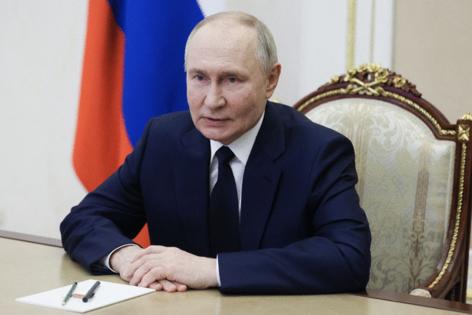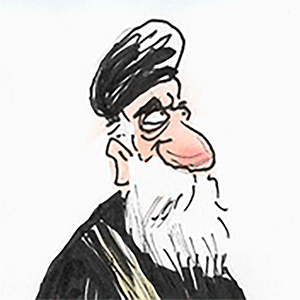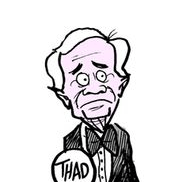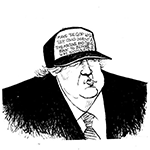Europe sees Putin forcing Trump into a tough choice on Ukraine
Published in News & Features
European officials say that Donald Trump is soon going to be faced with a difficult decision in his push to end Russia’s war in Ukraine.
Following three days of talks in Saudi Arabia that ended Tuesday, Russian officials said they want relief from some sanctions before implementing a ceasefire in the Black Sea, throwing a wrench into U.S. plans to quickly secure a wider deal.
The U.S. president has promised that he’ll achieve a swift end to the war in Ukraine as a sign of his prowess as a dealmaker and Russian President Vladimir Putin appears to be using that public position against him, some European officials said.
Moscow seems intent on prolonging discussions and keeping the scope of talks narrow to pressure the U.S. into giving ground, the officials said, asking not to be named discussing private assessments. Trump’s decision to link relations with Moscow to other U.S. concerns such as Iran and China has also provided Putin with leverage, they added.
All that means the U.S. leader may be forced to make a choice, the officials said: He can start pushing back on Russia or he can make increasingly consequential concessions to Putin in order to meet a self-imposed deadline for stopping the fighting.
“I think that Russia wants to see an end to it, but it could be they’re dragging their feet,” Trump said Tuesday in an interview with Newsmax.
After laying out its demands for sanctions relief at these talks, Russia will require future agreements to include similar guarantees of concrete benefits and not simply vague mutual concessions, according to one person with knowledge of the Kremlin’s thinking.
Ukrainian President Volodymyr Zelenskyy told reporters Tuesday that Russia is using Trump’s desire to deliver a ceasefire as an opportunity to insert its demands into agreements that were supposed to be unconditional. He said his forces would observe the partial truce immediately.
European officials said Tuesday night the mutual ceasefire was not in effect on the ground and details had yet to be finalized, despite Moscow’s claims it was already being implemented.
During parallel talks in Saudi Arabia with Ukrainian and Russian delegations this week, U.S. officials had been aiming to secure an immediate maritime ceasefire and a halt to attacks targeting energy infrastructure.
However, Moscow made its involvement in a Black Sea deal dependent on a series of preconditions, including sanctions relief. A Kremlin statement said that the moratorium on energy strikes had taken effect from March 18 for 30 days.
“The whole Black Sea deal has a secret objective — to start the lifting of American sanctions on Russia,” said Sergei Markov, a political consultant with close ties to the Kremlin.
There’s practically no military confrontation between Russia and Ukraine in the Black Sea at this point since Kyiv forced the Kremlin to relocate its ships with a series of sea drone attacks.
Zelenskyy aide Dmytro Lytvyn said on the social media platform X that at least eight Ukrainian energy assets had been hit since March 18. Every night Russia launches a barrage of drones and Ukraine shoots some of them down but doesn’t know what they were targeting, he said.
Overnight, Russia bombarded Zelenskyy’s home city of Kryvyi Rih with the largest drone attack since the start of the full-scale invasion, local authorities said. Russian drones also attacked the Black Sea port of Ochakiv on Tuesday night.
The U.S. said in a statement after the meetings that Moscow and Kyiv had agreed to work out mechanisms for implementing their ban on strikes against energy infrastructure.
The U.S. also “will help restore Russia’s access to the world market for agricultural and fertilizer exports, lower maritime insurance costs, and enhance access to ports and payment systems for such transactions,” according to the White House.
The Trump administration has previously indicated to allies that it won’t remove restrictions on trade with Russia until the war is over, although sanctions relief will likely be part of any agreement.
Among the Kremlin’s demands on Tuesday, the Russians called for some banks to be allowed to rejoin the international payments system SWIFT. In order for such a move to be effective, it would require agreement from the European Union, which has also restricted the lenders’ access to the system. European officials said that’s very unlikely and would require the unanimous backing of all 27 member states.
The Trump administration is aiming to reach a full ceasefire as soon as April 20, Bloomberg reported previously. But European officials said that is looking increasingly ambitious. Given the current status of talks, it would take months to work through the details of a final agreement, they said.
Despite Trump’s efforts, Putin’s main demands have not changed, according to Western officials. Those include wanting to neuter Ukraine’s military, annex territories that Moscow has occupied and illegally claimed are Russian and halting weapons deliveries to Kyiv.
The U.S. intelligence community’s own assessment published this week states that Russia and Ukraine may see a greater incentive to prolong the conflict instead of rushing into an unsatisfying settlement.
The European officials said they were hopeful that Trump will eventually conclude that Putin isn’t being reasonable or sincere about wanting a lasting peace agreement. Still, the officials said, the U.S. president’s eagerness for a rapid resolution makes it hard to predict what he will ultimately decide.
Trump has repeatedly said he believes that both Putin and Zelenskyy would like to see an end to the fighting — and that he personally wants to end both the violence and U.S. spending on aid to Kyiv.
“I just want to see it stop,” Trump told Newsmax. “I also don’t want to pay.”
©2025 Bloomberg L.P. Visit bloomberg.com. Distributed by Tribune Content Agency, LLC.







Comments